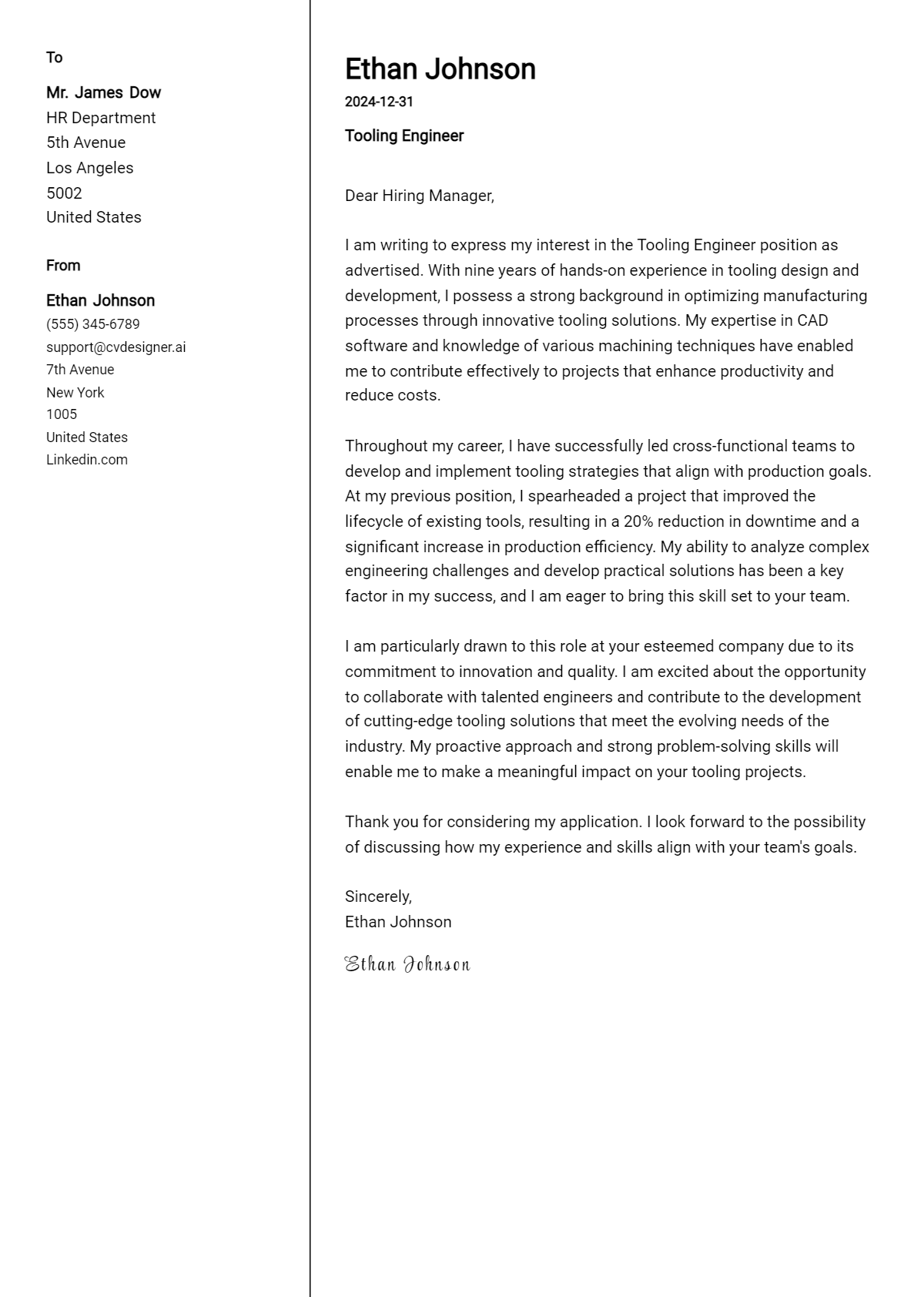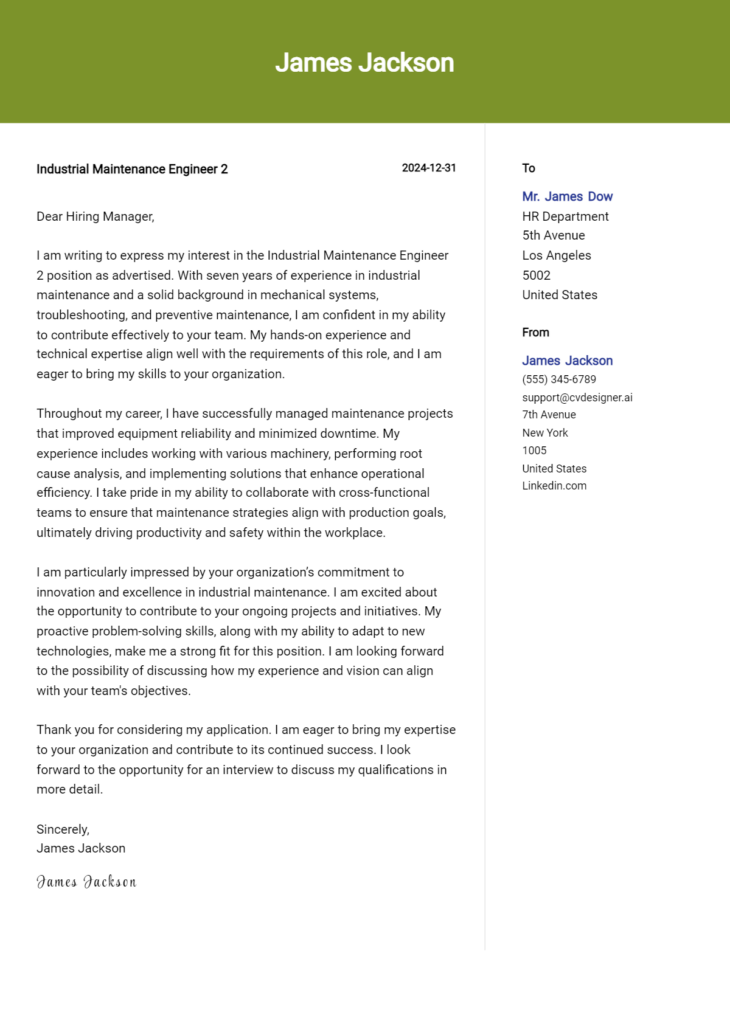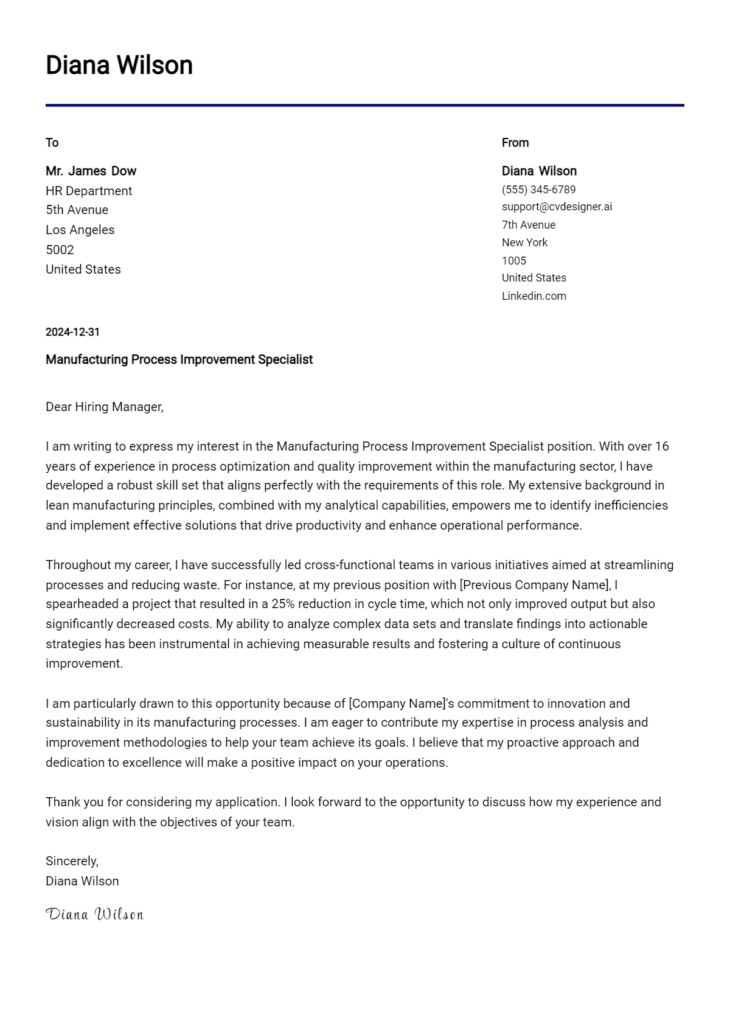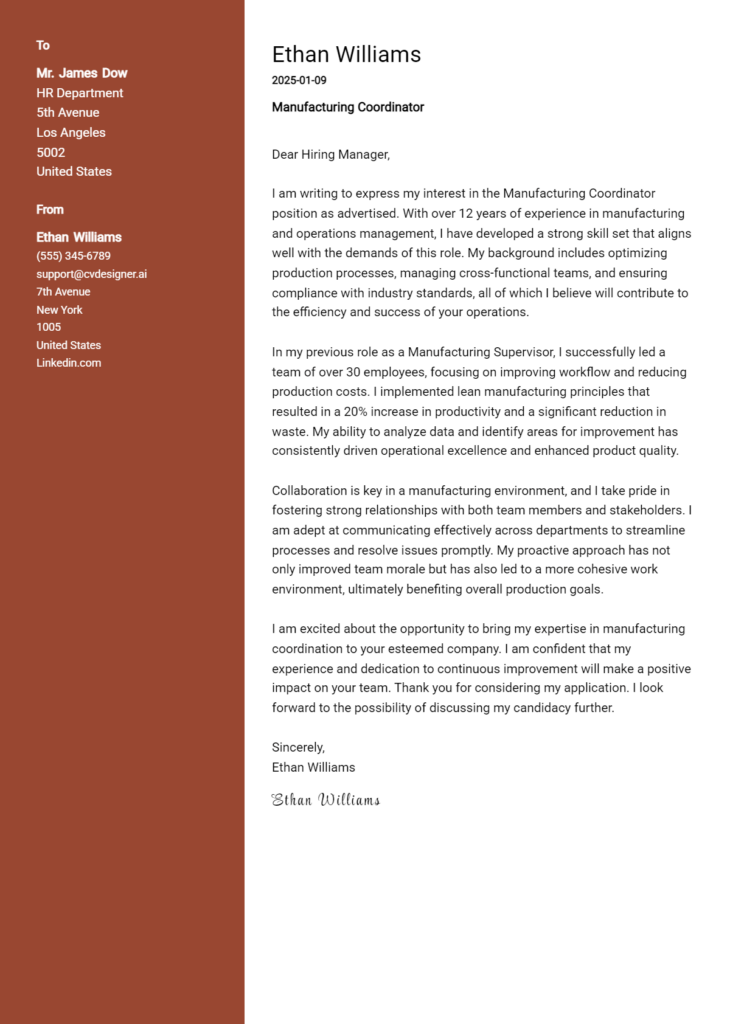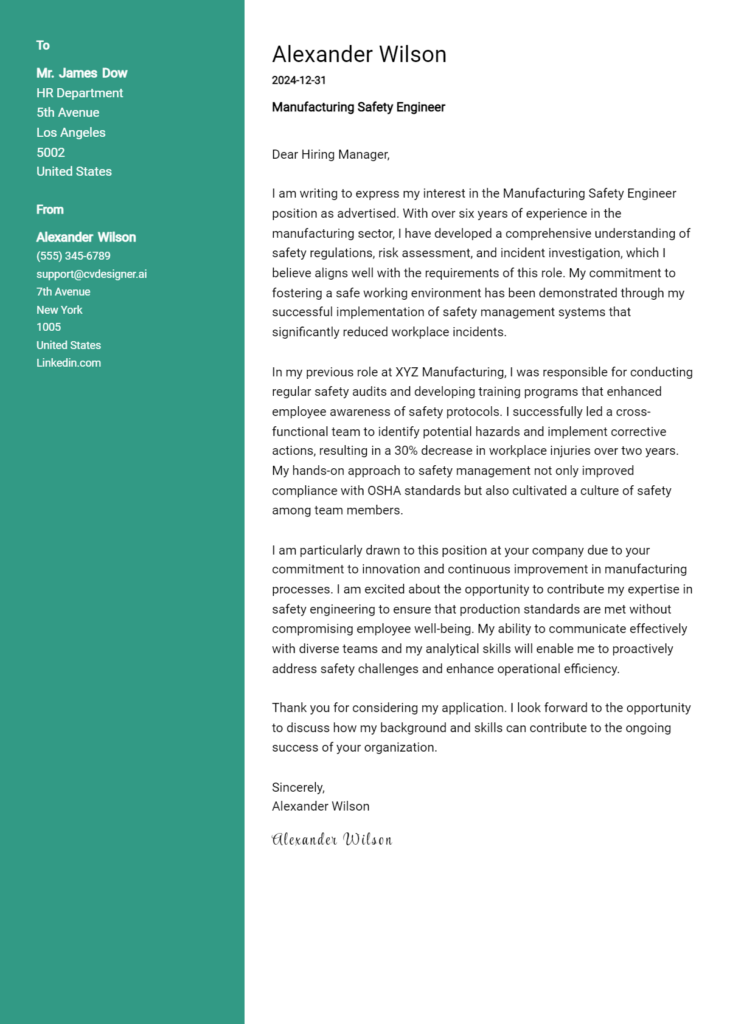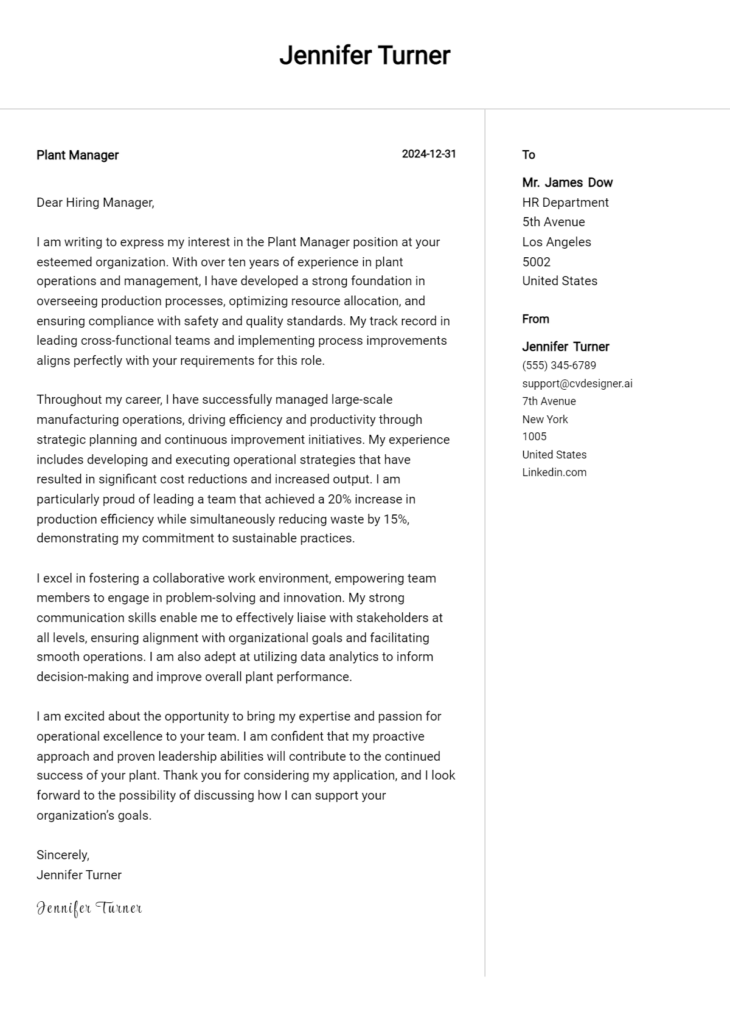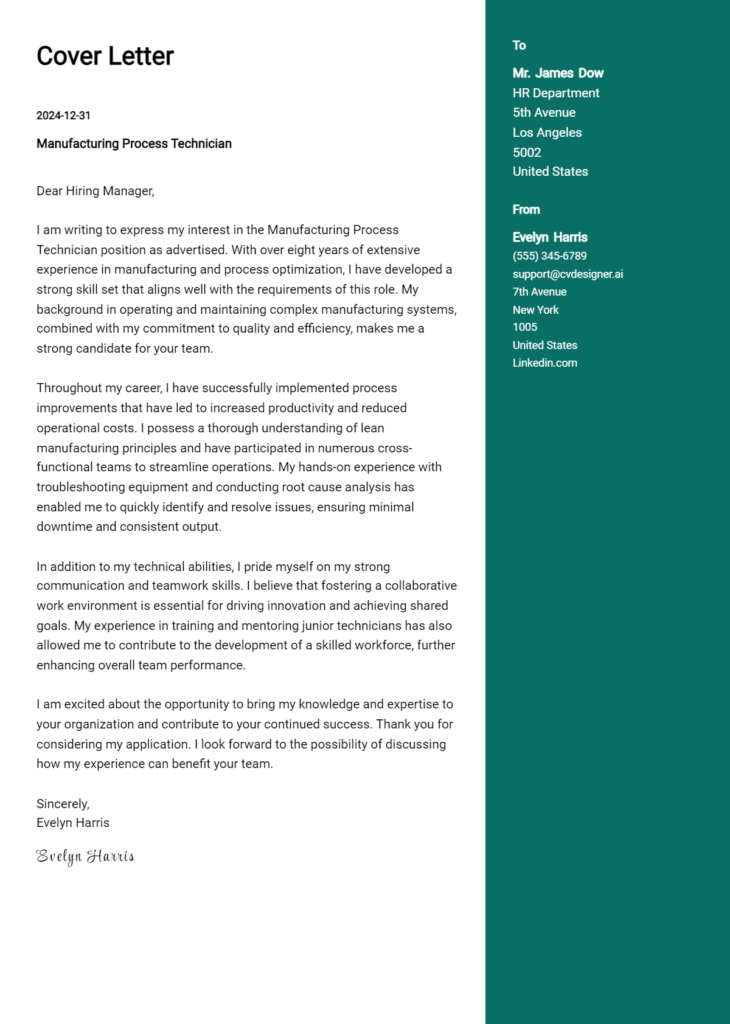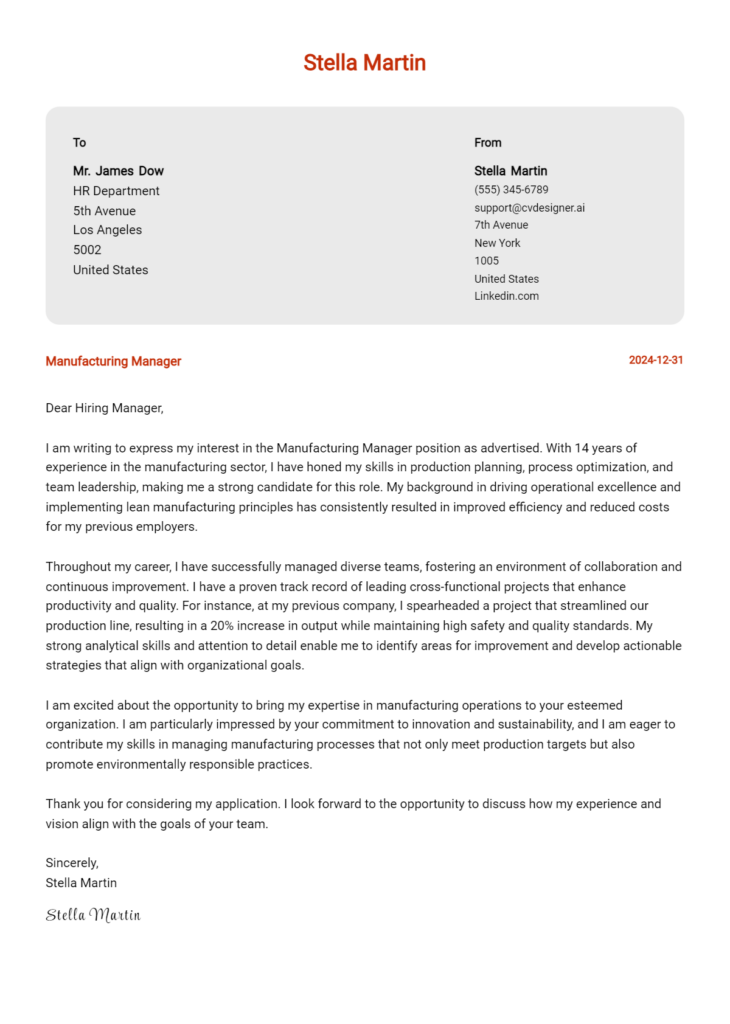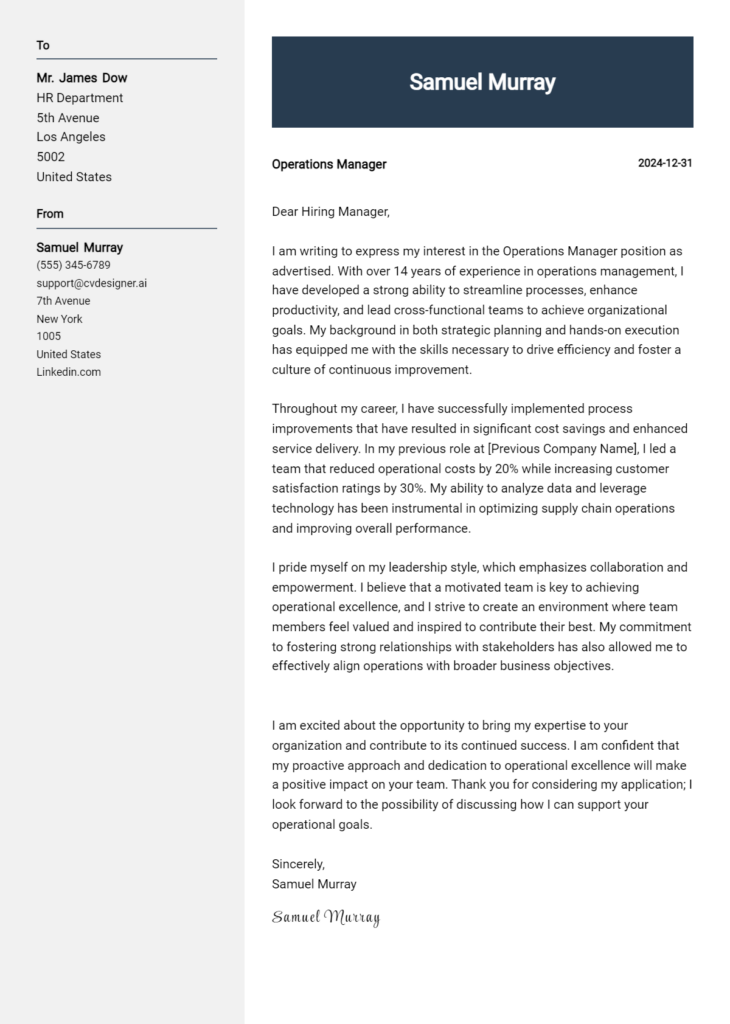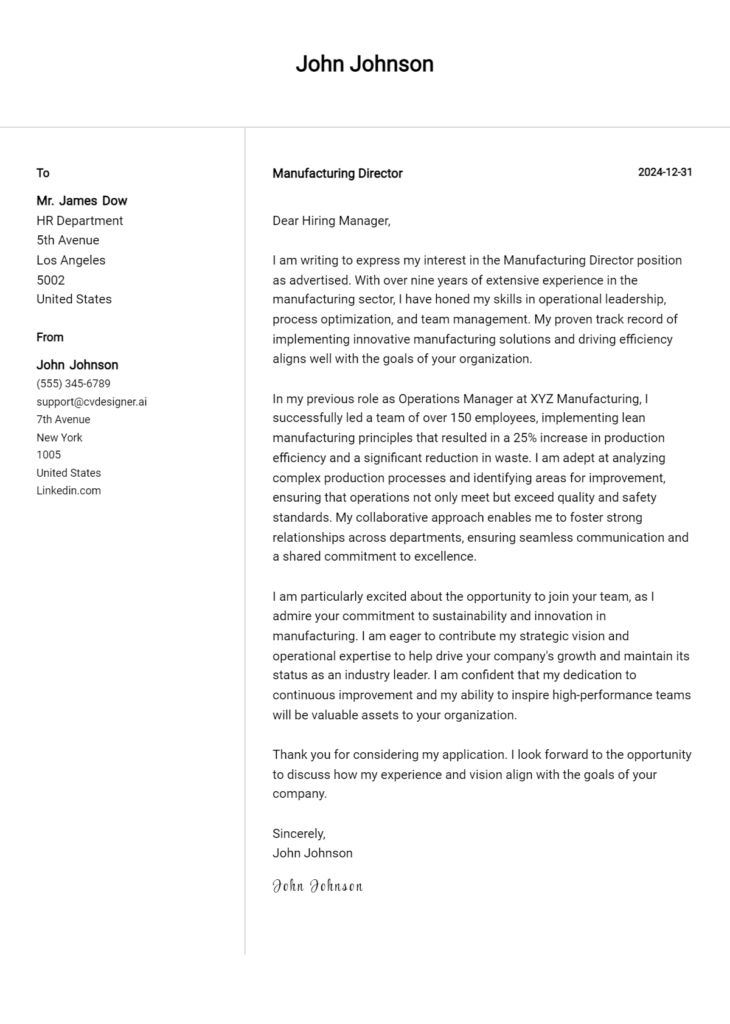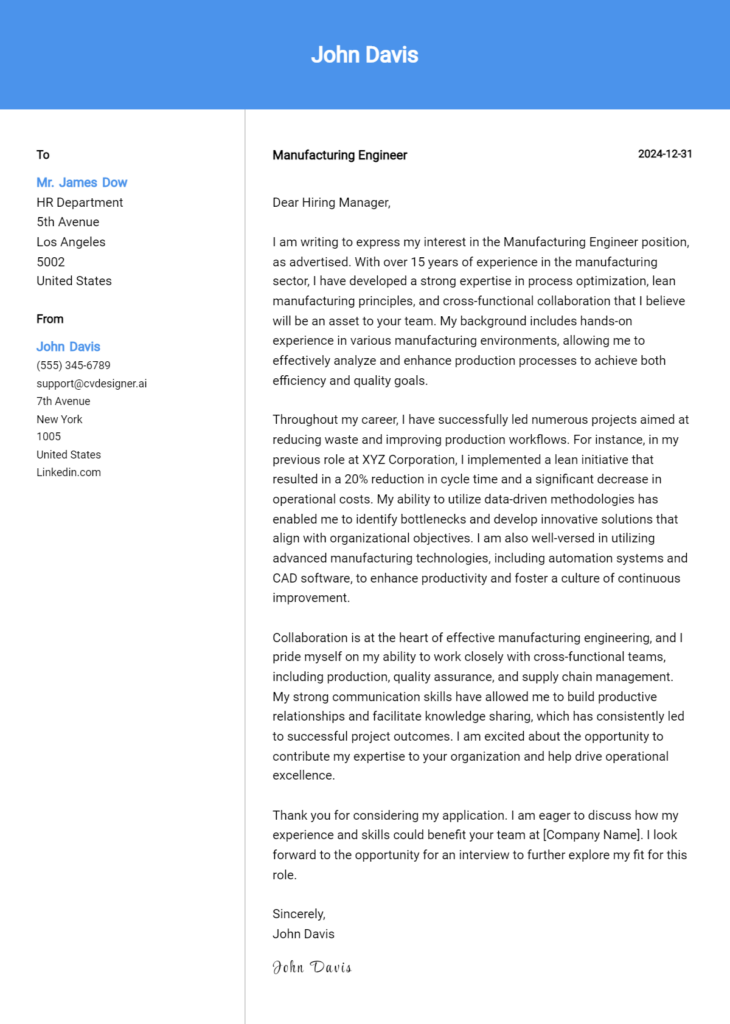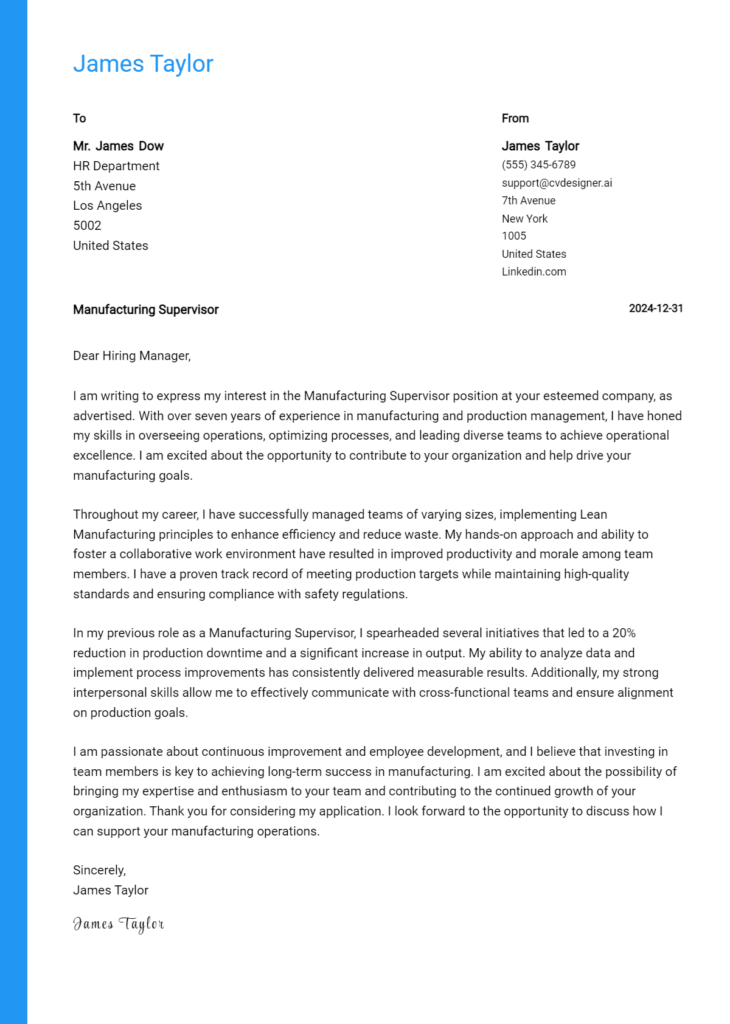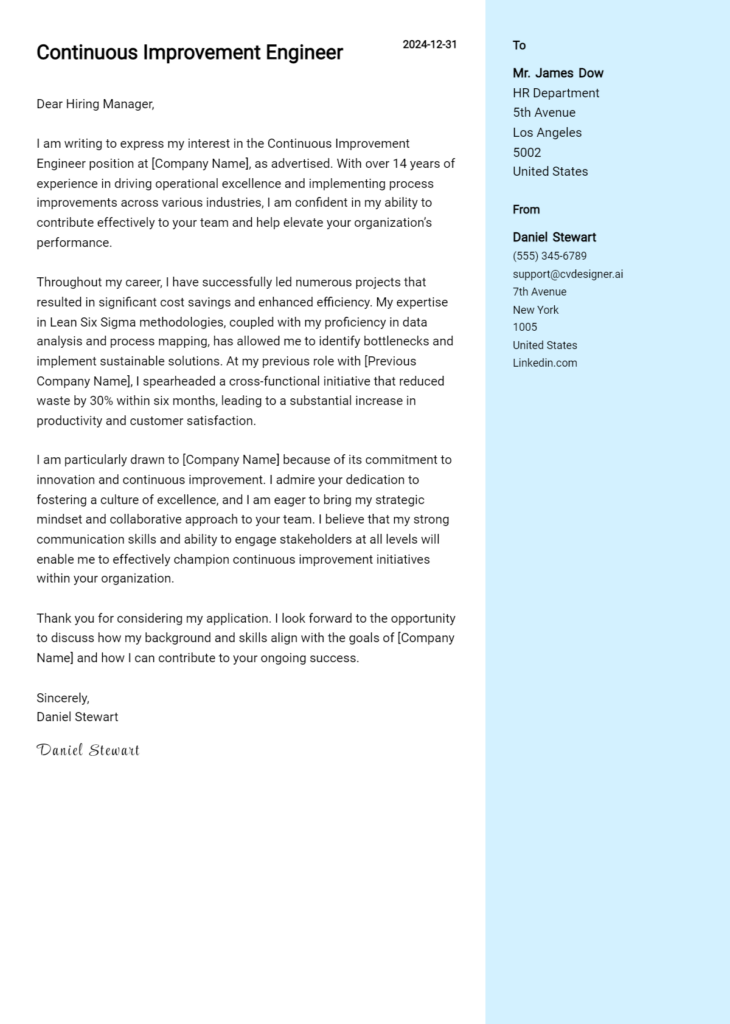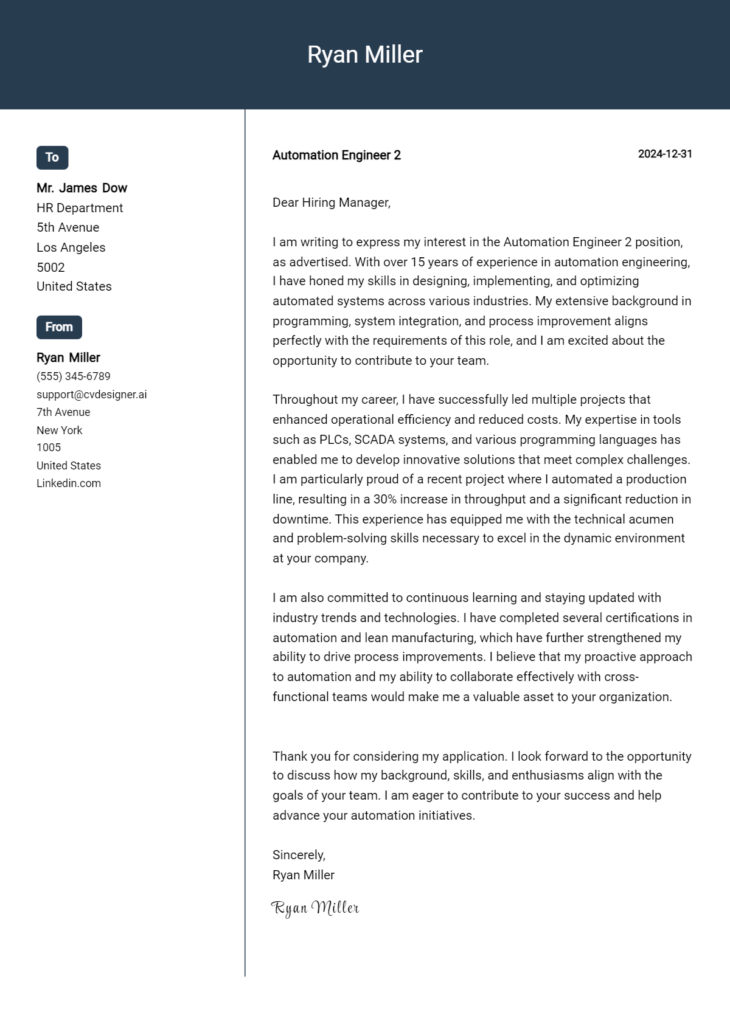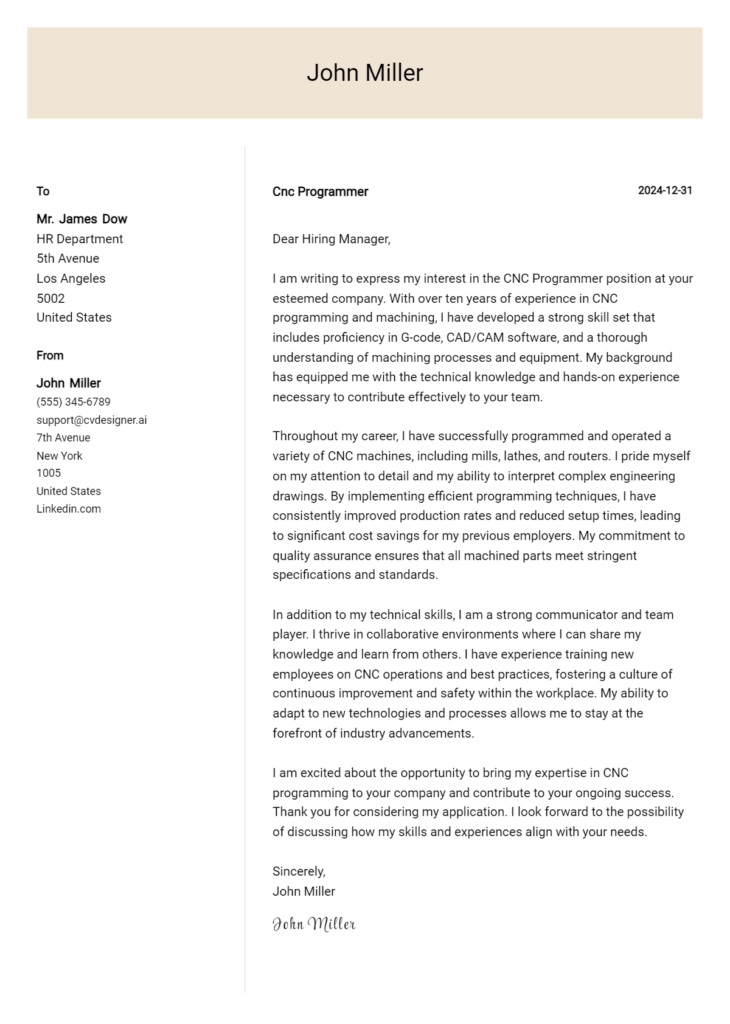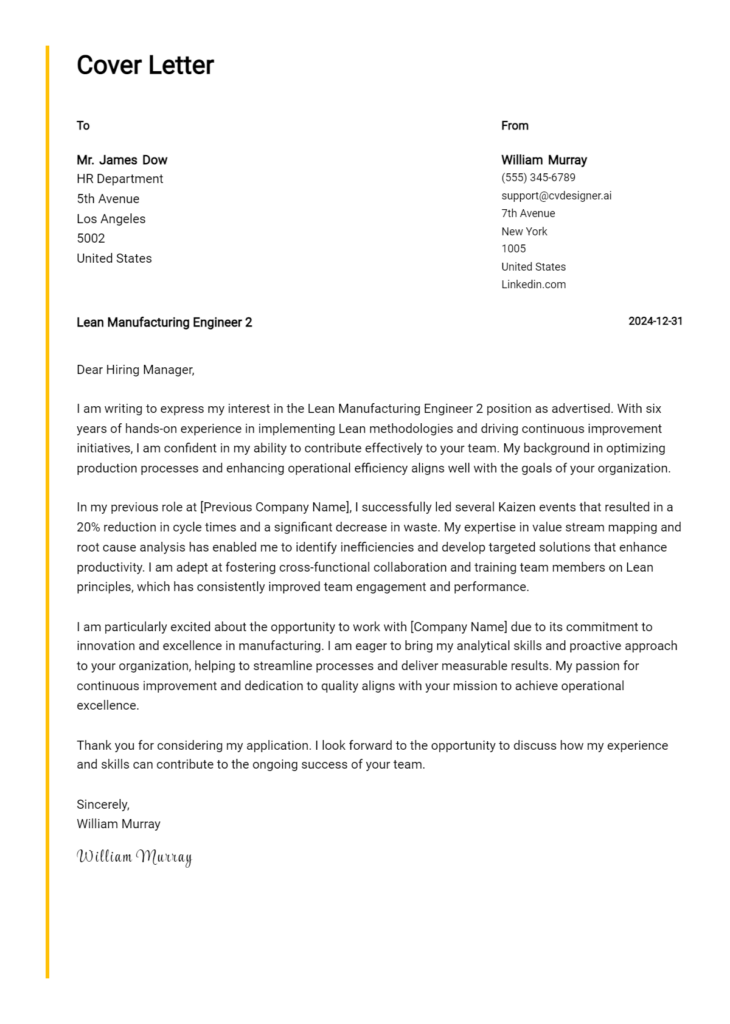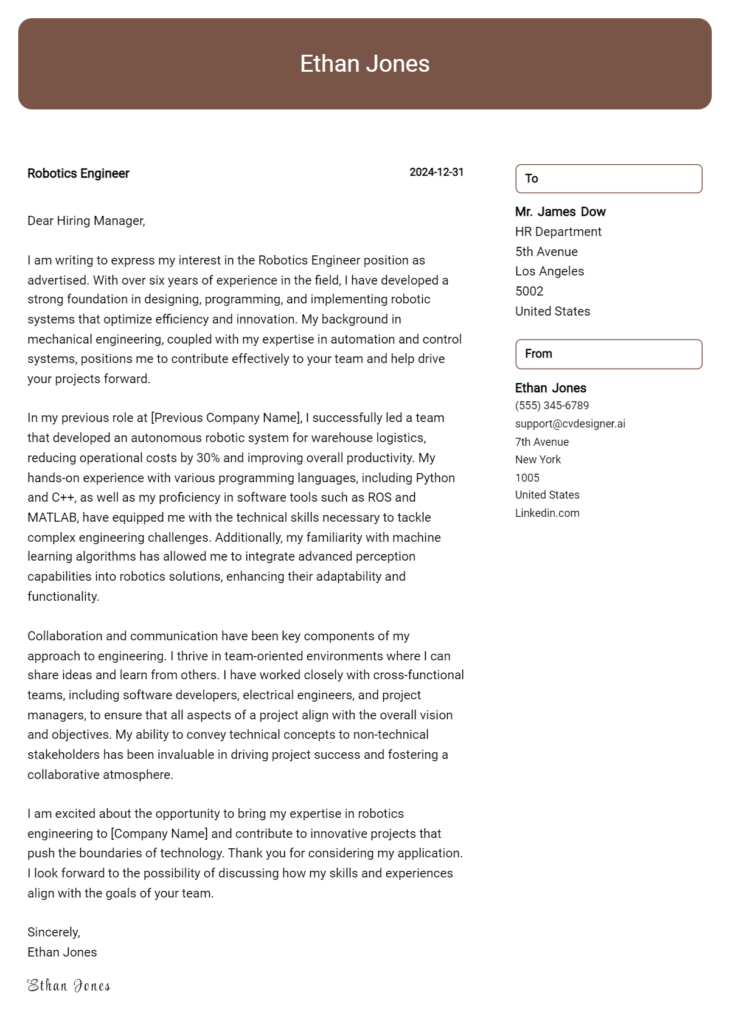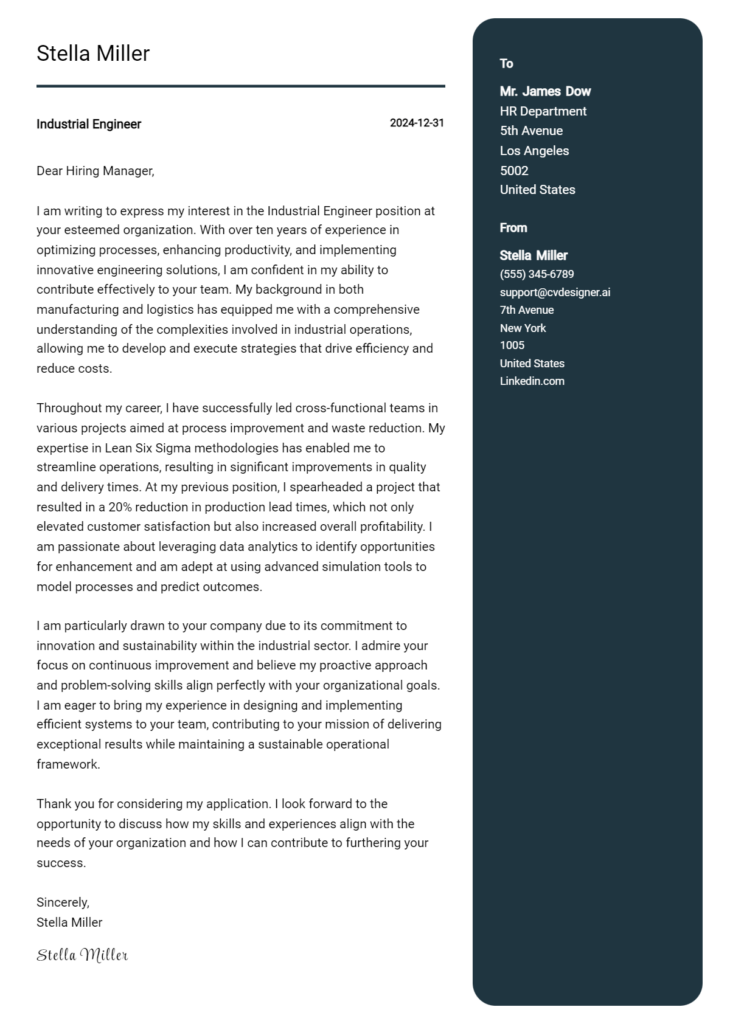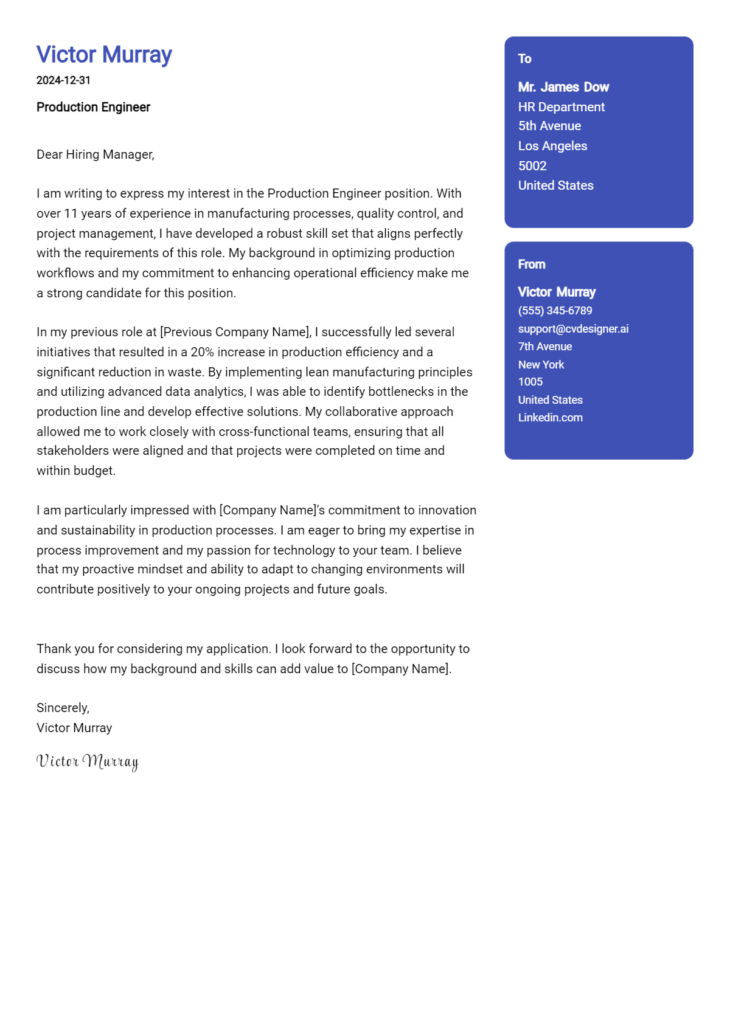Tooling Engineer Cover Letter Examples
Explore additional Tooling Engineer cover letter samples and guides and see what works for your level of experience or role.
How to Format a Tooling Engineer Cover Letter?
Crafting a compelling cover letter is essential for a Tooling Engineer, as it serves as your first opportunity to showcase your technical skills and problem-solving abilities. The format of your cover letter not only reflects your professionalism but also demonstrates your precision and attention to detail—qualities that are paramount in the engineering field. A well-structured cover letter can captivate hiring managers, making it easier for them to recognize your qualifications and fit for the role.
In this guide, we’ll outline the key components of an effective Tooling Engineer cover letter, providing insights and engineering-specific examples to assist you in creating a persuasive document.
We will cover the essential elements of a professional cover letter, including:
- Cover Letter Header
- Cover Letter Greeting
- Cover Letter Introduction
- Cover Letter Body
- Cover Letter Closing
Each section is crucial in emphasizing your qualifications and professionalism. Let’s delve into each part and discover how to make your Tooling Engineer cover letter stand out.
Importance of the Cover Letter Header for a Tooling Engineer
The header of a cover letter is a crucial element that sets the tone for the rest of the document. It serves as the first impression to potential employers and should reflect clarity and professionalism, particularly in a technical role like Tooling Engineer. A well-structured header includes the applicant's contact information, the date of writing, and the recipient's details, ensuring that the letter is easily identifiable and that all parties can communicate effectively. A strong header not only conveys professionalism but also indicates attention to detail—an essential trait for a Tooling Engineer.
Strong Example:
John Doe 123 Engineering Lane Tech City, ST 12345 john.doe@email.com (123) 456-7890 October 1, 2023 Jane Smith Hiring Manager Innovative Tooling Solutions 456 Manufacturing Blvd Industry Town, ST 67890
Weak Example:
john doe email: johndoe@email.com 10/1/23 to whom it may concern
The Importance of a Strong Cover Letter Greeting
The greeting of your cover letter is crucial as it sets the tone for the entire document. A well-crafted greeting reflects professionalism and shows that you have personalized your application for the specific job role. By addressing the hiring manager directly, you create an immediate connection, which can help you stand out in a competitive job market. Avoiding generic greetings, such as "To Whom It May Concern," is essential; instead, take the time to research the recipient's name and title. This simple act demonstrates your commitment and attention to detail.
Here are examples of strong and weak greetings for a Tooling Engineer cover letter:
Strong Greeting Example
Dear Ms. Johnson,
Weak Greeting Example
To Whom It May Concern,
The Importance of a Strong Cover Letter Introduction for a Tooling Engineer
A well-crafted cover letter introduction is crucial for a Tooling Engineer as it sets the tone for the entire application. It serves as the first impression to the hiring manager, capturing their attention in a competitive job market. An engaging introduction should express genuine interest in the role while succinctly highlighting relevant skills or achievements that demonstrate the candidate's qualifications. A strong introduction can effectively convey the candidate's enthusiasm and expertise, making them stand out from other applicants. Below are examples of strong and weak introductions to illustrate the difference.
Strong Example
Dear [Hiring Manager's Name], I am excited to apply for the Tooling Engineer position at [Company Name], as I have a profound passion for optimizing manufacturing processes and a proven track record of designing innovative tooling solutions that enhance productivity and reduce costs. With over five years of experience in the industry, I have successfully led projects that improved tool efficiency by 30%, and I am eager to bring my expertise in advanced CAD software and lean manufacturing principles to your esteemed team.
Weak Example
To whom it may concern, I am applying for the Tooling Engineer job. I have some experience in tooling and think I would be a good fit. I’ve done some projects in the past, and I hope you consider my application.
Cover Letter Body for Tooling Engineer
The body of a cover letter for a Tooling Engineer is crucial as it allows the candidate to present their qualifications, relevant experiences, and specific skills that align with the job requirements. This section is an opportunity to highlight significant projects, accomplishments, and contributions to previous employers, demonstrating the candidate's ability to effectively design, develop, and implement tooling solutions. By providing concrete examples of past successes, such as improving manufacturing efficiency or reducing production costs through innovative tooling designs, the candidate can showcase their value to the company and their potential impact on future projects.
Strong Example
I am particularly proud of my role in the design of a new injection molding tool that reduced cycle time by 20% in my previous position at XYZ Manufacturing. By collaborating closely with the production team and utilizing CAD software, I was able to identify bottlenecks and implement design changes that not only enhanced productivity but also improved the overall quality of the molded parts. This project not only saved the company approximately $50,000 annually but also resulted in a 15% increase in customer satisfaction ratings due to the higher quality output. I am eager to bring this proactive approach and my extensive experience in tooling design to the Tooling Engineer position at your company.
Weak Example
I have worked as a Tooling Engineer for several years and have experience with different types of tools. I think I would be a good fit for your company. I have done some projects in the past, but I can't remember the details right now. I believe I can help your team.
Importance of the Cover Letter Closing for a Tooling Engineer
The closing paragraph of a cover letter is crucial as it reinforces the applicant's qualifications, expresses enthusiasm for the position, and prompts the hiring manager to take the next steps, such as reviewing the attached resume or scheduling an interview. A strong closing leaves a positive impression, while a weak one may diminish the overall impact of the application.
Strong Example
In conclusion, I am excited about the opportunity to bring my expertise in tooling design and process optimization to your team at [Company Name]. With my proven track record of improving production efficiency and my commitment to innovation, I am confident that I can contribute significantly to your projects. I look forward to the possibility of discussing how my skills align with the needs of your organization. Thank you for considering my application; I hope to speak with you soon to explore this opportunity further.
Weak Example
I think I would be a good fit for this job. I hope you look at my resume. Thanks for your time.
These tips will help candidates craft an effective cover letter for a Tooling Engineer position, an essential tool for making a strong first impression on potential employers. A well-written cover letter should not only highlight your technical skills and problem-solving abilities but also demonstrate your knowledge of the Software Development Life Cycle (SDLC), your ability to work within a team, and your passion for continuous learning. This combination will set you apart from other candidates in this competitive field.
Tips for Writing Your Tooling Engineer Cover Letter
Showcase Your Technical Skills: Begin your cover letter by clearly outlining your relevant technical skills. Mention specific tools, programming languages, and methodologies you are proficient in, such as CAD software, CAM systems, or any relevant scripting languages. This immediately establishes your qualifications and relevance to the role.
Highlight Problem-Solving Abilities: Tooling Engineers often face complex challenges that require innovative solutions. Include examples of past projects where you successfully identified issues and implemented effective solutions. Use metrics or outcomes to quantify your impact, showcasing your critical thinking and problem-solving skills.
Demonstrate Knowledge of SDLC: Emphasize your understanding of the Software Development Life Cycle, especially how tooling fits into the overall process. Discuss your experience in various stages of the SDLC and how you have contributed to improving processes, enhancing productivity, or ensuring quality.
Emphasize Teamwork: Collaboration is key in engineering roles. Share experiences that highlight your ability to work effectively within a team, emphasizing how you’ve contributed to group projects or supported colleagues. Mention any cross-functional teams you've worked with and the importance of communication in achieving project goals.
Express a Passion for Continuous Learning: The field of engineering is constantly evolving, so it’s crucial to demonstrate your commitment to ongoing education and professional development. Mention any certifications, courses, or workshops you have completed recently. This shows that you are proactive in keeping your skills relevant and are eager to grow within your profession.
For added convenience, consider utilizing cover letter templates or a cover letter builder to help structure and refine your cover letter, making the writing process more efficient and effective.
Common Mistakes to Avoid in a Tooling Engineer Cover Letter
Avoiding common mistakes in a cover letter is crucial for standing out in the competitive field of tooling engineering. A well-crafted cover letter can highlight your qualifications and set you apart from other candidates. Here are some common pitfalls to watch out for:
- Generic Content: Using a one-size-fits-all approach can make your letter forgettable. Tailor your letter to the specific job and company.
- Neglecting Format: Poor formatting can detract from your message. Ensure you follow a professional cover letter format to create a polished appearance.
- Lack of Specific Examples: Failing to provide concrete examples of your experience can weaken your application. Use specific achievements that demonstrate your skills in tooling engineering.
- Ignoring the Employer’s Needs: Focus on how your skills meet the employer’s requirements rather than just listing your qualifications. Research the company to align your letter with their goals.
- Spelling and Grammar Errors: Typos can create a negative impression. Always proofread your letter or have someone else review it before submission.
- Being Too Vague: Avoid being overly broad in your descriptions. Use precise language to convey your expertise in tooling processes and technologies.
- Missing a Strong Closing: An effective closing can leave a lasting impression. End with a call to action, expressing your enthusiasm for the role and inviting further discussion.
For more guidance, explore cover letter examples that can inspire your writing. By steering clear of these mistakes, you'll be better positioned to make a compelling case for your candidacy as a Tooling Engineer.
Cover Letter FAQs for Tooling Engineer
What should I include in my cover letter as a Tooling Engineer?
In your cover letter, emphasize your technical skills, experience with tooling design, and knowledge of manufacturing processes. Start with a strong introduction that captures the hiring manager's attention. Include specific examples of previous projects where you successfully designed or improved tooling, highlighting your problem-solving abilities. Mention any relevant software proficiency, like CAD programs, and your understanding of materials and machining processes. Don’t forget to express your enthusiasm for the industry and the company. Tailoring your cover letter to the specific job description will show that you've done your research and understand the company's goals.
How can I showcase my achievements in my cover letter?
To effectively showcase your achievements, use quantifiable metrics wherever possible. Instead of simply stating that you designed tooling, mention how your design reduced production time by X% or decreased scrap material costs by Y%. Use bullet points to highlight key accomplishments, ensuring they relate directly to the requirements of the job you are applying for. Additionally, recount specific challenges you faced in previous roles and how your innovative solutions led to success. This will provide concrete evidence of your capabilities and demonstrate your value as a Tooling Engineer to potential employers.
Is it necessary to customize my cover letter for each job application?
Yes, customizing your cover letter for each application is essential. A tailored cover letter allows you to align your skills and experiences with the specific requirements of the job. It shows the employer that you have taken the time to understand their needs and how you can meet them. Reference the company's projects, values, or recent news to demonstrate your genuine interest. Additionally, addressing the hiring manager by name, if possible, adds a personal touch. A generic cover letter may fail to grab attention, whereas a customized one can significantly increase your chances of landing an interview.
How long should my cover letter be for a Tooling Engineer position?
Your cover letter should ideally be one page long, consisting of three to four paragraphs. Start with a strong introductory paragraph, followed by a brief section that summarizes your relevant experience and skills. Use the middle section to showcase your achievements and how they relate to the job description. Conclude with a call to action, expressing your eagerness for an interview. Keep your sentences concise and focused, ensuring that every word adds value to your application. A well-structured and succinct cover letter not only respects the hiring manager's time but also highlights your professionalism.
Build your Cover Letter in minutes
Use an AI-powered cover letter builder and have your letter done in 5 minutes. Just select your template and our software will guide you through the process.

